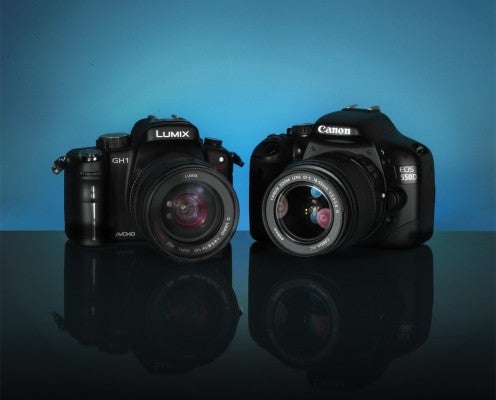Sound and Verdict
Sound Quality
Sound is something that perhaps hasn’t been top priority in the advancement of DSLR/MSC video modes, and as a result it can often be fairly poor. Early models relied on a single mono source on the body and no option for external inputs.
The GH1 is a slight exception as it includes full stereo sound and a Dolby digital surround creation built in to the body, it also offers an external mic input, such as Panasonic’s own mini boom mic. Though due to the 2.5mm socket, most third party mics will require a 3.5 to 2.5mm adapter to connect them.
The 550D sticks with the basic mono microphone built into the body for general use but it does, at least, offer external stereo input via a 3.5mm socket.
Both models record the sound at a relatively high sample rates simular to that of CD quality. However, despite the superior stereo microphone, the GH1’s audio sounded slightly muffled compared to the 550D when played back via headphones. Though this may have been a result of the surround sound processing. One thing missing from any of these type of cameras, is a method of monitoring the sound when recording – something that would be almost a necessity for any serious filmaker.

Panasonic GH1 audio sample

Canon 550D audio sample
Verdict
The results of this test were far closer than we ever expected and, as such, making a clear-cut decision on the best model for video is not easy. We had to be very clear that these scores were for the video use only, as both cameras have already been tested and overall we believe the EOS 550D to be the stronger camera.
In video terms the GH1 does have some advantages over the 550D: the focusing is quicker in low light, and offers continuous focusing – though not overly effectively; the inbuilt microphone is stereo; the lens is far superior; clip length is longer and files smaller; the LCD screen can be angled for viewing, and the electronic viewfinder can be used during video too. On the EOS 550D’s side: the screen quality is much higher and gives a more accurate representation of the image; the ISO range goes higher for low light shooting; the mic input is a standardised 3.5mm; it offers a greater array of lenses; it offers a full progressive HD capture in a more useable MOV format, and it is cheaper to buy.
The actual size difference between the two cameras is actually less in practical terms than the specs would suggest, and once lenses are taken into consideration the weight is practically the same. In real terms you would be happy with the results from either of these cameras. The Canon’s videos are slightly more natural where the Panasonic’s are punchier but neither come close to HD video produced by the EOS 5D MkII, or even the EOS 7D, and therefore both are a compromise. As a complete package, the Lumix GH1 offers everything you would need. However, If you are looking to expand into a video system, by adding more lenses with a move to upgrade to the likes of the 5D in the future, the 550D makes perfect sense and, being the cheapest here, it is a better starting point for most.
Scores
Panasonic Lumix GH1

Canon EOS 550D






